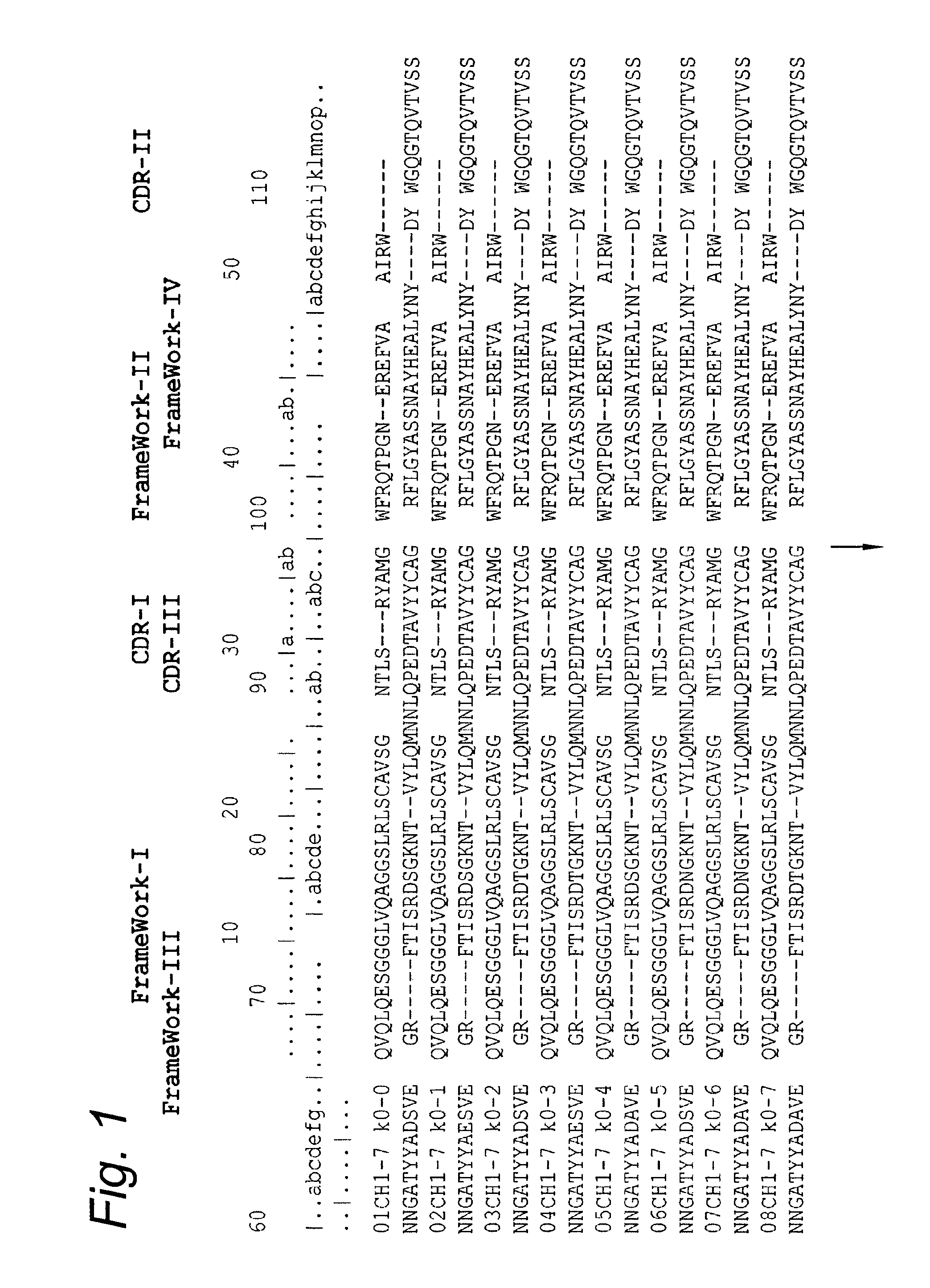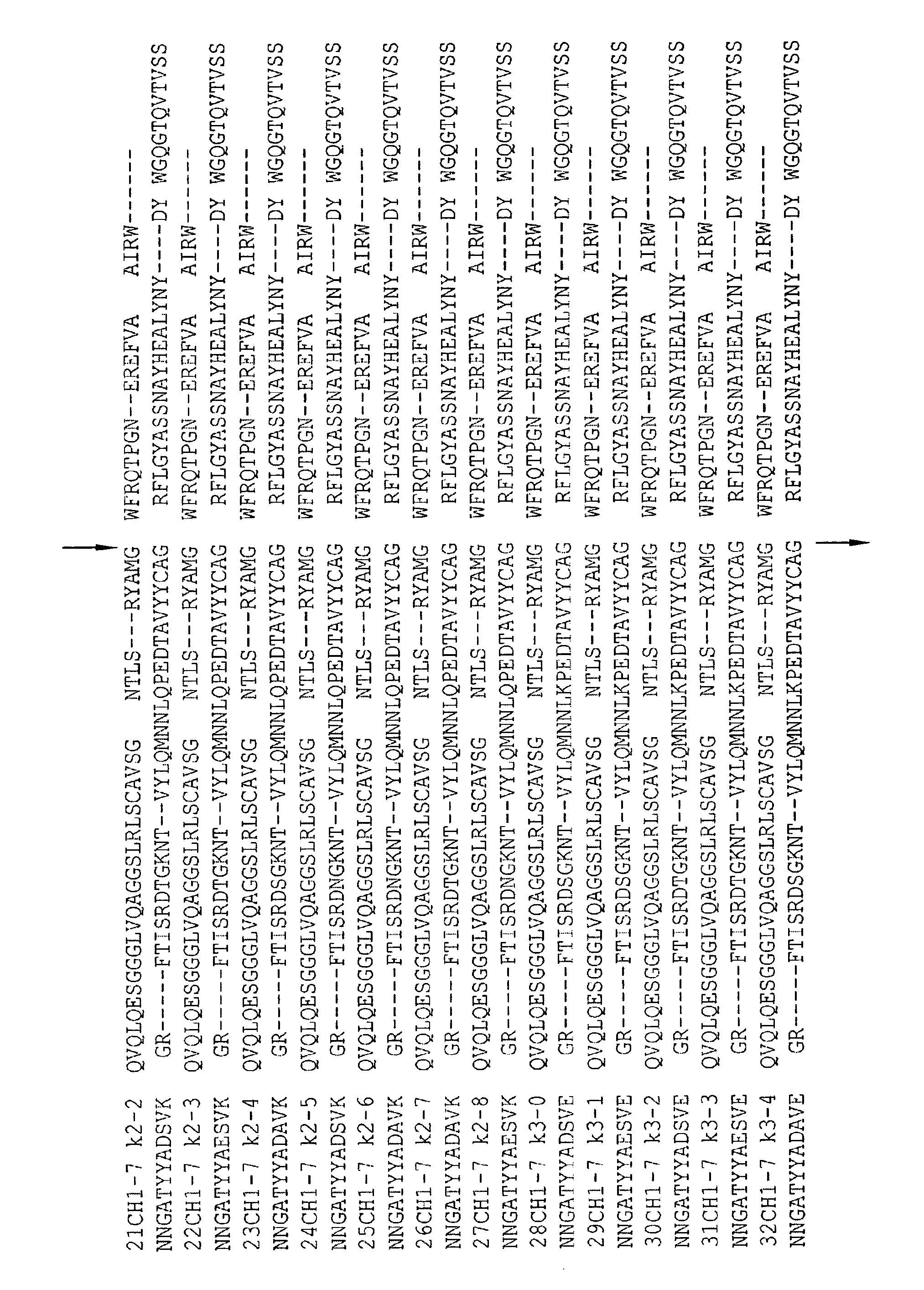Antigen-Binding Protein Directed Against Epitope in the CH1 Domain of Human IgG Antibodies
a technology of igg antibodies and antigens, applied in the field of biochemistry and immunology, can solve the problems of low antibody levels, inability to selectively capture human igg derived fab fragments from feed stock samples, and inability to bind to human vh3 domains, etc., to achieve low antibody levels and facilitate purification and detection
- Summary
- Abstract
- Description
- Claims
- Application Information
AI Technical Summary
Benefits of technology
Problems solved by technology
Method used
Image
Examples
example 1
Identification of IgG-CH1 Binding VHH Fragments
[0129]The VHH fragments binding to the CH1 domain of IgG antibodies were identified from llamas immunized with human IgG antibodies and / or Fab fragments thereof. Screening of individual VHH fragments from the constructed expression libraries was performed by ELISA using different human antibody isotypes and subclasses and fragments thereof, which resulted in identification of a panel of VHH fragments binding to the CH1 domain of IgG from different mammalian species and human IgG1 to 4 in particular.
[0130]For screening purposes Maxisorp binding plates (Nunc) were coated with human antibody antigens and subsequently blocked with 2% (w / v) milk powder (Protifar) in PBS. Bound VHH fragments were detected by either a mouse anti-Myc mAb in combination with a polyclonal goat-anti-mouse-HRP conjugate (Bio-Rad, 172-1011) or a polyclonal rabbit anti-llama-VHH serum in combination with a polyclonal swine-anti-rabbit IgG-HPO conjugate (Dako, P217). ...
example 2
DNA Sequencing of IgG-CH1 Binding VHH Fragments
[0135]The amino acid sequences of the anti IgG-CH1 binding VHH fragments were determined via DNA sequencing and is presented in FIG. 1 (SEQ ID's: 1 to 158). Although the isolated VHH fragments originate from different llamas immunized with different types of antibody antigens, the CDR regions of all sequenced anti IgG-CH1 VHH fragments show remarkable similarities, thereby indicating recognition of the same epitope as present on the CH1 domain of IgG antibodies. The IgG-CH1 epitope being recognized by the antigen-binding proteins of the current invention therefore seems to be unique in its ability to generate an immune response in the llama through eliciting a significant enrichment of anti IgG-CH1 VHH antibody fragments belonging to a rather conserved sequence family.
example 3
IgG Species Selectivity of IgG-CH1 Binding VHH Fragments in Biacore
[0136]In order to further specify the epitope on IgG CH1 domains that is recognized by the antigen-binding proteins of the current invention, the binding reactivity's towards IgGs from a panel of different species were analyzed using surface plasmon resonance analysis (SPR) on a Biacore 3000 system. Based on the observed cross-species reactivity, the different CH1 amino acid sequences could then be aligned and analysed on potential unique and / or discriminating residues and / or residue combinations. For this purpose the binding agents were immobilized onto the surface of a CM5 sensor chip. Subsequently, the sensor chips were incubated with purified IgG antibodies (20 μg / ml) and / or serum (20× diluted) from different species in HBS-EP buffer (0.01 M HEPES, pH7.4; 0.15 M NaCl; 3 mM EDTA; 0.005% Surfactant P20). Binding was allowed for 1 minute at 5 μl / min followed by a dissociation step of 2.5 minutes at 5 μl / min. Binding...
PUM
| Property | Measurement | Unit |
|---|---|---|
| pH | aaaaa | aaaaa |
| affinity | aaaaa | aaaaa |
| degree of purity | aaaaa | aaaaa |
Abstract
Description
Claims
Application Information
 Login to View More
Login to View More - R&D
- Intellectual Property
- Life Sciences
- Materials
- Tech Scout
- Unparalleled Data Quality
- Higher Quality Content
- 60% Fewer Hallucinations
Browse by: Latest US Patents, China's latest patents, Technical Efficacy Thesaurus, Application Domain, Technology Topic, Popular Technical Reports.
© 2025 PatSnap. All rights reserved.Legal|Privacy policy|Modern Slavery Act Transparency Statement|Sitemap|About US| Contact US: help@patsnap.com



